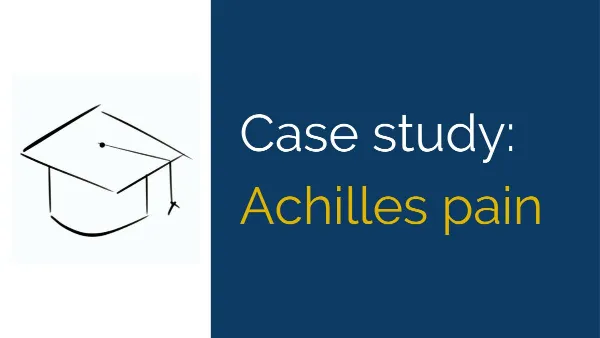Background – Achilles pain
This Achilles pain case will test your knowledge of different pathologies that can cause pain around the Achilles region, your ability to plan the physical examination to differentiate between those pathologies and how your rehabilitation will differ for each pathology.
Minimum Level
Physiotherapist with 2+ years experience
History
Gerry is a 48 year old male with a sedentary desk job. He has a very long history of Achilles pain, commencing around 12 years ago when he returned to playing football after a prolonged absence.
There was no incident that triggered the onset of symptoms.
The football competition is recreational/social level, runs over five months and has one game every Thursday with no team training sessions.
Explain how the format of the competition may increase the risk of Achilles Tendon issues.
Gerry recalls that when the Achilles pain first started, the pain only occurred after games and resolved by the next morning. However after a few months, the pain had become more intense and would linger for 2-3 days after games.
After a mid-season Physiotherapy assessment, Gerry was advised to do daily calf raises and stretch regularly, including before games. He found the stretches to be effective at reducing the pain at the start of games but did not have an effect of the pain after games. He didn’t find the exercises helpful at all and ceased them after 4 weeks.
Comment on heel raises and stretches as a management plan.
Towards the end of the season, the pain would be present all week, although it would gradually reduce in intensity in the days before each game.
After the season finished, Gerry began road running 2-3 times per week for 6-12km per run to maintain fitness. The Achilles pain persisted and was felt at the start of every run.
For some runs, the Achilles would “loosen up” and feel better during the running; on other occasions, it would worsen during the run and Gerry would abandon the run after 5-6km.
Regardless of the pain pattern during the run, the Achilles pain would always worsen after the run and cause considerable pain on ADLs and walking for several days, until the next run.
In the last 12 months, pain with running is more noticeable with uphill or faster running.
There is still the residual ache for days after a run but it’s now also sensitive to pressure, particularly when Gerry accidentally hits it against furniture or wears a tight pair of shoes (like leather dress shoes).
Gerry tried his previous Physio rehab plan but feels that daily stretching and calf raises actually made his symptoms worse this time around.
Do you have a possible explanation on why his previous approach may not be helping?
Gerry mentions that his tendon has been thicker on that side since the injury started, but it doesn’t seem any worse in the last 12 months.
Does this tendon thickening affect your diagnostic rationale?
Are there any diagnoses that are more or less likely due to this observation?
Gerry is getting frustrated that the Achilles pain seems to be worsening; he’s also concerned about the Achilles tendon eventually rupturing.
Comment on Gerry’s concern regarding his Achilles pain leading to an Achilles tendon rupture.
(Mention any research support that you know of, although it’s not a critical element of this explanation.)
Gerry would like some advice on resolving the condition, training options, footwear recommendations and whether a scan would be warranted.
Further questioning
What additional information would you like to know from Gerry?
Provisional diagnoses
What are your provisional diagnoses at this stage? Justify each based on features from the history.
Describe the pathophysiology of your provisional diagnosis.
Explain if/how the following factors would impact the pathology of your provisional diagnosis:
1. BMI = 28
2. Sedentary job
3. Poor nutritional intake
4. Age = 48 years
5. Male gender
Physical examination
Give an overview of your physical examination.
Justify three key tests – explain what information you expect to gain and how this will help with your diagnosis or rehab planning.
Imaging
Would you consider any imaging for Gerry?
If so, explain which scan you would select and how this will impact your management.
If not, explain your rationale.
Rehab planning
Nominate your provisional diagnosis and design a rehabilitation plan for Gerry.
State the purpose of each exercise or intervention with respect to the pathology.
Specify the timeframe for any noticeable change in symptoms for each component of your management.

